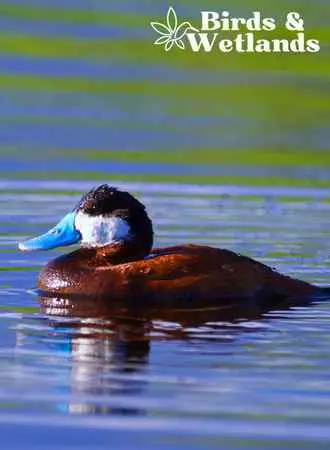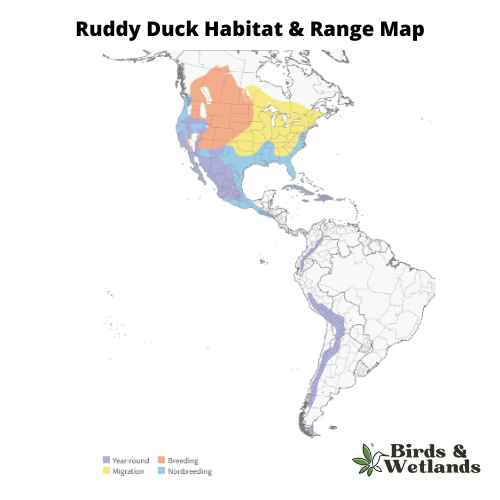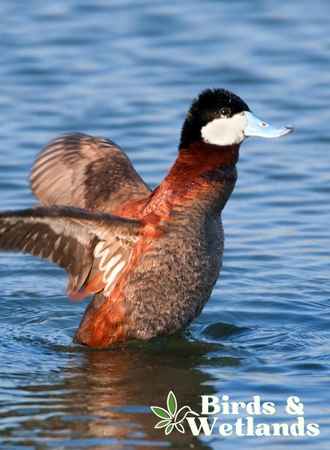The ruddy duck is a species of duck native to North America. It is a small bird with distinctive blue bills and brownish plumage, where it got its common name.
The ruddy duck belongs to the genus Oxyura. The word “Oxyura” comes from the Greek words “oxys,” meaning sharp or pointed, and “oura,” meaning tail. This refers to the ruddy duck’s distinctive tail, which is short and stiff and extends straight into the air when the bird is swimming.
Scientific Name: Oxyura jamaicensis
Length: 13.8-16.9 in (35-43 cm)
Wingspan: 22.1-24.4 in (56-62 cm)
Weight: 10.6-30.0 oz (300-850 g)
Description
Male ruddy ducks have slightly peaked heads, a blackish cap contrasting with their bright white cheeks. Its body is a rich chestnut color and has a bright blue bill. Solidly dark tops of the wings are visible when in flight. They have fairly short necks and stiff tails, which they frequently hold cocked upward.
The adult female ruddy duck in summer plumage is browner than the male. It has a dark brown forehead and crown. The head is white with a dark brown stripe on the cheek and fine brown streaks.

Listen to Ruddy Duck
Habitat
During breeding, it prefers freshwater habitats with dense marsh vegetation, such as shallow lakes, ponds, marshes, rivers, and reservoirs. These plants protect against predatory birds and mammals while providing food for insects and aquatic invertebrates.

Range
Ruddy ducks breed in Canada and the United States, with dispersed populations in northern Mexico and the Caribbean.
During the winter, these compact ducks migrate to habitats ranging from most of the United States to Mexico and Central America.

Diet & Feeding Habits
The ruddy duck is a diving duck that forages for food both above and below the water’s surface. Its preferred diet consists primarily of aquatic plant seeds and roots, but also feeds on aquatic insects and crustaceans.
These ducks search for food underwater by straining mud from the bottom of the water body with their scoop-shaped bills.
These ducks usually feed at night,.

Nesting & Mating Habits
Pairs form in late winter or before spring migration.
The female builds her nest out of dry stems of floating plants and lines it with down feathers to keep it warm. It is raised slightly above the water and is anchored to nearby shore vegetation.
She lays 5 to 10 creamy white eggs and occasionally lays them in the nests of other ducks, grebes, or rails.
After 22 to 26 days of incubation, the chicks are precocial and ready to leave the nest within a day of hatching. They can swim and dive almost immediately, though their mother usually guards them to keep them safe.
As the chicks grow, they can fly when they are 42 to 49 days old.

Population & Conservation Status
The species is currently listed as “Least Concern” by the IUCN due to its wide range. However, these ducks still face threats such as climate change, predation and human disturbance.
Hunting
Ruddy ducks migrate during the fall and winter, so they are available for hunting in most states that allow waterfowl hunting. When specifically targeting ruddy ducks, however, some states have more restrictive laws than others.

Key Points
- Males have blackish caps, rich chestnut bodies, dark tops on the wings, thick necks and bright blue bills while winter males are dull gray-brown with dull-gray bills.
- Females and first-year males have brown overalls with a blurry stripe and pale cheek patch.
- These ducks inhabit marsh habitats with dense vegetation.

